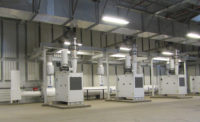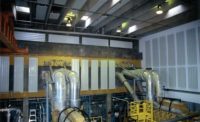Industrial plants are known for being loud, acoustically-harsh environments. The combination of high ceilings, reflective surfaces and heavy machinery din creates an environment for reverberation and noise. Such conditions can decrease productivity and increase health and safety hazards.
This is especially true for wastewater treatment plants where the combination of high-speed, high volume air blowers and concentrators, high ceilings, and hard, easily-cleanable surfaces combine to create a unique noise problem. Facility managers and operators at the Southerly and Jackson Pike Wastewater Treatment Plants in Columbus, Ohio, as well as officials in the city’s Division of Sewerage and Drainage, were well aware of these risks.
The best solution
Since 2007, the city and its wastewater treatment plant managers have worked diligently to rectify noise and reverberation issues. Over the years they have determined that the installation of acoustic noise-absorbing panels was the best solution. That was true again for the most recent projects at the Jackson Pike and Southerly facilities.
In the West Aeration Control (WAC) Building Blower Room at the Southerly plant, the existing drop-ceiling tiles had become severely corroded and deteriorated, making them useless for mitigating noise. Even brand new, such tiles simply can’t reduce reverberation enough to fully protect operator hearing and improve verbal communication. According to the city of Columbus Project Manager who oversaw the project and the engineering firm hired to tackle the problem, acoustic noise-absorbing panels were specified because of the positive results achieved in other areas of the facility. The decision was made to remove the existing ceiling tile system and install acoustic panels.
The WAC blower room contains five 900hp DeLaval blowers, each with a diameter of 24 in., speed of 3,500 rpm, generating 20,000 CFM of air. The blowers provide excess air to the continuous activated sludge/nitrification process, which removes ammonia from the wastewater treatment stream. Depending how much additional air is needed to support that process—related to both the flow and nitrogen content of the stream—more than one blower at a time may be engaged.
The WAC blower room is approximately 208 ft. long by 40 ft. wide and 20 ft. high. It has walls made of concrete masonry units (CMUs), glass and drywall; terrazzo floors; and a concrete ceiling. Those reflective surfaces are incredibly unforgiving in terms of reverberation, especially in a space that large.
Analyzing data
An acoustic consultant performed onsite analysis of the conditions in the room to determine the average reverberation time and noise level at specific frequencies. The tests revealed an average reverb time of 7.5 seconds and an average noise level of 93.6 dB at 500 Hz, confirming the noise-level problem in the space. Understanding these data and knowing the success of prior installations of acoustic panels at the Southerly plant, he believed that same type of panel would do the job.
The consultant, in collaboration with the engineering firm, designed a panel layout that would reduce the reverb time to just 1.2 seconds at 500 Hz. That design had to accommodate installation around lighting fixtures, sprinkler systems, electrical conduits, roof drains and other equipment. Achieving that target reverb time required about 13.5% of the walls and 30% of the ceiling to be covered with noise-absorbing panels at a mounting distance of 4 in. off the wall. In total, 226 EFPs were installed in sizes including 30 in. x 5 ft., 30 in. x 6 ft., 30 in. x 8 ft. and 30 in. x 10 ft. to accommodate the wall and ceiling utilities. Installation was performed with minimal impact to plant operations.
There’s clear and powerful evidence of the marked difference that the acoustic panels made in the Southerly’s WAC Building Blower Room.
“Before the installation, our operators were required to wear hearing protection at all times. After the job was done, that was no longer the case,” said Jeff Bartoe, Southerly Wastewater Treatment Plant Maintenance Manager.



